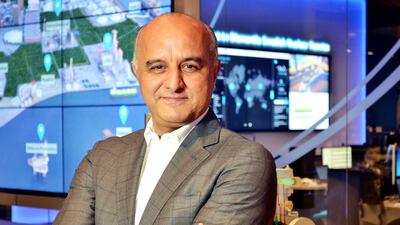Iraq has added around 400 megawatts (MW) to its power grid from the first wave of flared gas recovery this year, according to the US oil services firm Baker Hughes, a General Electric company (BHGE), which works with the country's oil ministry to process gas associated with oil production from the country's vast southern fields.
"The figures vary when it comes to the flared gas but it's very obvious that it's one of the highest globally. I would say that we're able to take Nassiriya and Al Gharraf field and, just by addressing that flared gas from these two fields, provide 400MW to the grid," Rami Qasem, the BHGE president Middle East North Africa, Turkey and India told The National in Abu Dhabi.
Iraq is one of the biggest flarers of gas associated with oil production as it lacks infrastructure to process it, according to the World Bank, despite the country's significant power requirements.
The World Bank estimates around 16 billion cubic metres of gas from Iraqi fields was flared in 2015, costing the economy billions in lost revenue. Power outages in the war-torn country, particularly in the summer when temperatures often reach 50° Celsius have led to protests against the government.
The Iraqi oil minister Jabbar Al Luaibbi has prioritised the recovery of gas that would otherwise be flared and outlined plans in April to build three new plants to process the fuel from its southern fields.
___________
Read more:
Rosneft pays Kurdistan $1.3bn upfront in production deal
Iraq ratchets up oil export capacity by 900,000 a day
___________
BHGE signed a contract with the Iraqi oil ministry in July to develop a modular natural gas liquids plant to recover 5.7 million cubic metres a day of dry gas, liquefied petroleum gas and condensate from gas currently being flared from the Nassiriya and Gharraf fields.
“There are a couple of plants we’re working on based on a ministry direct negotiation and our ability to provide financing support. There's another one being tendered for another company. They’re evaluating a couple of proposals on the table,” said Mr Qasem.
“We’re using very simple math to see how much we can treat and take the gas through our single model equipment, which will help us to have the installation within 8 to 12 months from the day we’re awarded the contract. The ministry, especially the minister himself, is driving the projects in the country. The shortage of gas they have in some of the areas in the south makes this all the more important,” he added.
Lorenzo Simonelli, the president and chief executive at BHGE said the company was bullish on growth opportunities in Iraq, where the energy ministry is looking to upgrade the country’s refining and power infrastructure after the liberation of cities such as Mosul that were previously controlled by the ISIL.
“Iraq remains a country with opportunities and it’s continuing to redevelop its economy and with stability comes the opportunity for further growth,” Mr Simonelli said.
Baker Hughes merged with General Electric in July to create the world’s second-largest oilfield services provider, BHGE.


